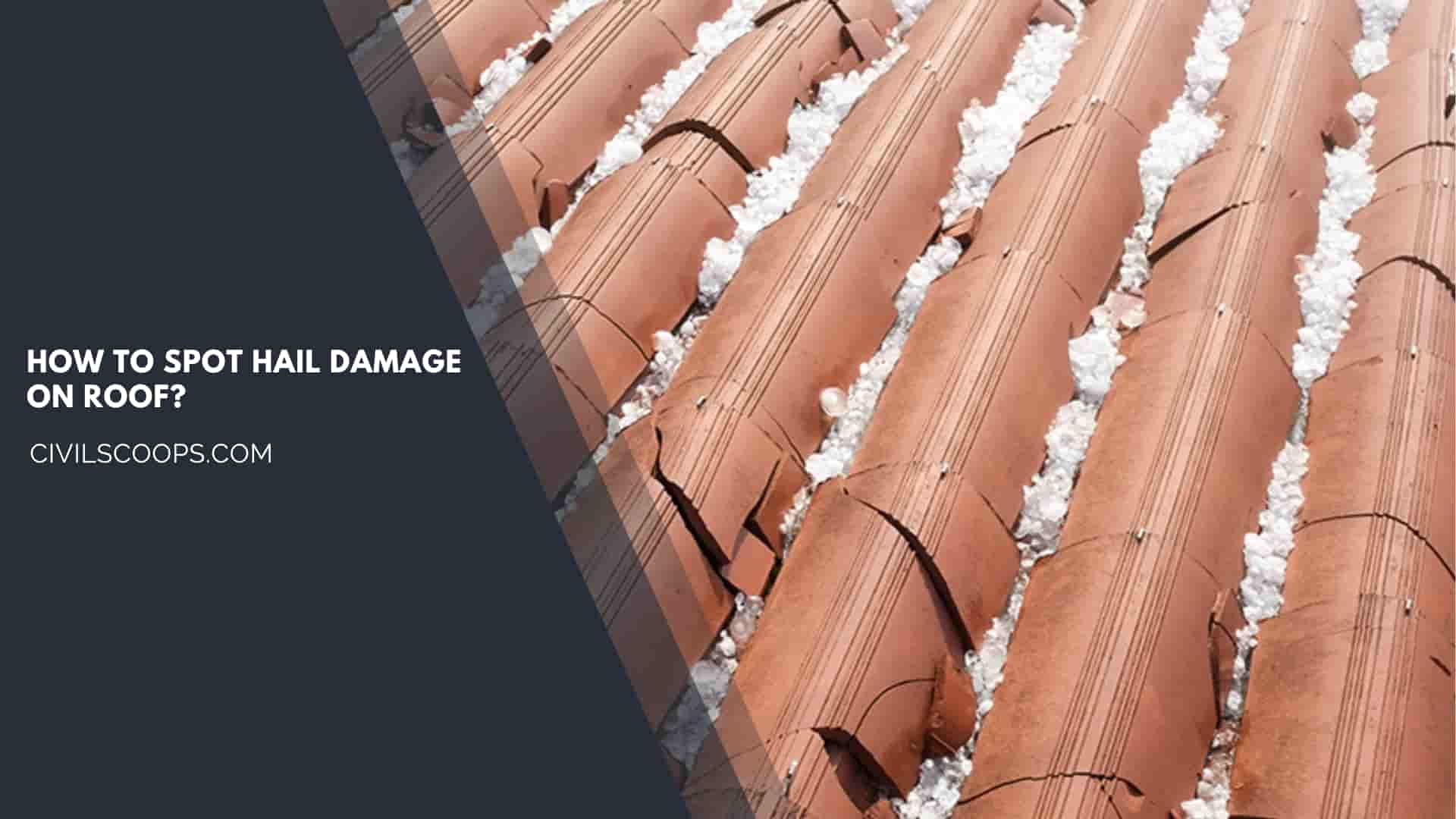
Table of Contents
How to Spot Hail Damage on Roof?
Generally, when assessing hail damage metal roof vulnerabilities, it’s evident that hail damage can have a significant impact on roof covering materials and other properties.
Many homeowners often wonder, ‘how do you know if your roof has hail damage?‘ or ‘what does hail damage look like on a roof?
A hail storm can be very destructive and dangerous.
So, there are some factors to determine the impact of hailstorm damages, which affects the different types of shingles and roofing materials, those are-
1. Wind
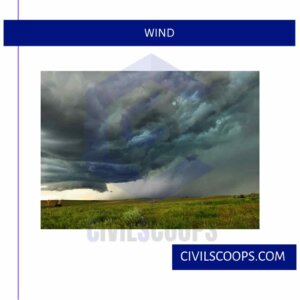
In the time of storm, the wind speed varies continuously; so, the direction and speed of wind are continuously changing.
This changing direction of Hail affects the location of roof shingles and other roofing materials.
2. Size and Density
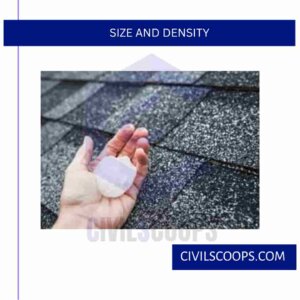
The intensity of the storm is directly proportional to the size and density of the hail; so, if the size of the hailstorm is more, then the damage is also serious.
Hail storms may be very small, or sometimes it is huge.
Hailstorms carry hailstones that do not have smooth edges; so, the impact of those hailstones creates a deep impact on your roof shingles or roofing materials.
3. Building Materials

Building materials also play an important role.
Different types of building materials absorb different hail impacts. Due to Hail, dings in gutters, aluminum siding, asphalt shingles have happened.
Wooden shingles or vinyl siding are also badly affected due to Hail because they are not as strong as aluminum.
Hailstones are very dangerous, and small hailstones have enough capacity to damage a roof; so, the longevity of the roof could affect this effect.
Hailstones do not have smooth edges, and they are rough and sharp enough to damage a roofing material easily.
Also Read: Types of Gable Roof
Useful Article for You
- What Is a Highway Flyover
- What Is Grouting
- What Is a Pile Cap
- What Is a Bond Beam in Masonry
- What Is Sapwood
- What Is Crane
- What Is a Gable
- What Is Superelevation
- What Is Kerb
- What Is the Purpose of Washers
- What Is the Size of a Brick in Inches
- What Is Reinforced Masonry
- What Is Workability
- What Is Bond Breaker
- What Is Plasticizer in Concrete
- What Is Luminous Flux Vs Lumens
- What Is Caisson
- What Is a Benchmark Surveying
- What Is Bracing in Construction
- What Is a Beam in Construction
- What Is the Standard Door Frame Size
- What Is a Spandrel Beam
- What Is a Weep Hole
- What Is Tie Beam
- What Is Fine Aggregate
- What Is Pony Wall
- What Is Flag Stone
- What Is Development Length
- What Is Cement Plaster
- What Is a Pitched Roof
- What Is a Slab in Construction
- What Is a Monolithic Slab
- What Is Linear Distance
- What Is Shovel
- What Is Lintel in Construction
- What Is a Concept Sketch
- What Is Mezzanine Floor
- What Is Man Sand
- What Is Plaster Made Out of
- What Is a Floating Slab
- What Is Falsework
- What Is Bituminous
- What Is a Spillway
- What Is Curb and Gutter
- What Is Dampness
- What Is Lap Length
- What Is the Full Form of Fsi
- What Is Door Frame
- What Is Plinth Protection
- What Is Traffic Rotary
- What Is Grade Slab
- What Is Rolling Margin of Steel
- What Is Modulus of Rupture
- What Is Fresh Concrete
- What Is Dpc in Construction
- What Is Earthen Dam
- What Is Plum Concrete
- What Is Shell Structure.
- What Is Lumber
- What Is the Strongest Foundation for a House
- What Is the Meaning of Soundness of Cement
- What Is Flyover Bridge
- What Is Under Reamed Pile
- What Is Weir
- What Is Inverted Beam
- What Are the Advantages of Levelling?
- What Is Sunk Slab
- What Is Brick Bat Coba
- What Is Isolated Footing
- What Is Long Column
- What Is Plate Load Test
- What Is Formwork
- What Is Concealed Beam
- What Is Acp
- What Is Wbm Road
- What Is Slab
- What Is Quick Setting Cement
- What Is Rapid Hardening Cement
- What Is Perennial Canal
- What Is Wpc Board
- What Is Grade of Cement
- What Is Culvert Bridge
- What Is Ferrocement
- What Is Mortar in Construction
- What Is Floating House
- What Is Combined Footing
- What Is Estimation?
- What Is the Si Unit of Weight
- What Is a Basement
- What Is Pert and Cpm
4. Barriers:
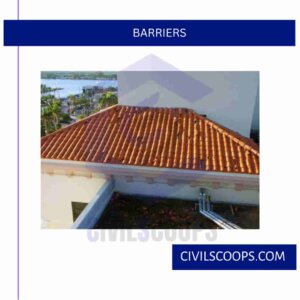
Barriers can protect your buildings or your property from dangerous hail damage.
So, barriers like fences, homes near your house, natural barriers like tree covers, landscaping, etc. It can protect you from the hail damage effect.
What Is Hail and How Does It Form?
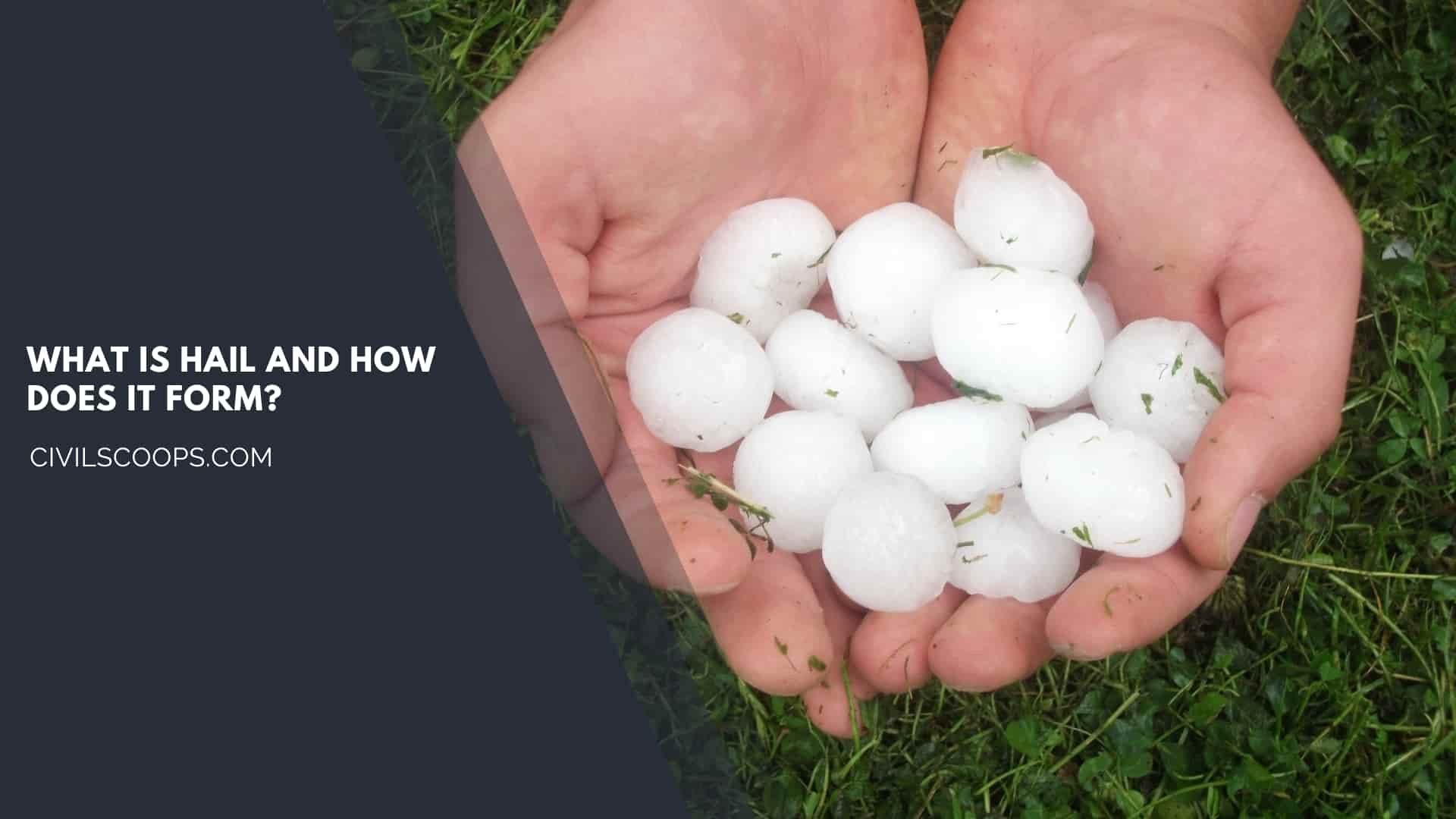
In simple words, Hail can be defined as a crystallized piece of snow.
Many a time, hail is confused with the ice pellets, but that’s often not the case.
Ice pallets are generally solid precipitation of particles less than 5mm, which are generally spherical and circular but rarely conical in shape.
Ice pallets are generally formed as the raindrops fall through the cold air.
The raindrops, as they fall through cold air and clouds, soon lose their temperature and come in Sub-zero temperature.
As they come to Subzero temperature, a thin layer of ice is formed, converting the liquid raindrops.
Many a time, while falling through the air, a fall in temperature might be witnessed, thus again converting the ice pallets into raindrops.
The size of ice pallets is far smaller than the size of Hail, so it does not damage any roofs while falling.
Many times, while falling through, the thin layer of ice is again broken and again reverts back to its original form, that is, liquid rainwater.
Thus it can be said that Hail is generally formed keeping a lot of ice pallets together.
The formation of Hail can be generally witnessed in cold regions. In those regions, and in all other regions as well, the air temperature rises as the height gets increased.
Thus the temperature of the air at a higher place is larger than the temperature of the air at a lower place, keeping the geotechnical coordinates the same.
As per the concept of transpiration, the warmer air gets upward, while the colder air gets downward.
So the process starts from the evaporation of water due to continuous heat.
As the water evaporates from the surface sources, it gets stored up in the lower layer of air, which is, in fact, warmer.
Due to the up drift of warmer air(meaning warmer air gets higher), the rainwater stored in the lower layer of air gets upwards.
As the temperature of the upper air is much below the lower air, the raindrops generally fall below Sub zero temperature and form thin ice.
As the weight of the ice is greater than the raindrop itself, it falls in the lower layer of air. As it falls in the lower layer of air, it generally melts into raindrops again.
As the lower layer of air also consists of moisture; thus the raindrops collect more moisture and turn slightly bigger.
Due to the up drift of air, the raindrops again go into the upper layer of air, falling at a Subzero temperature and again forming ice pallets, which is slightly bigger than before.
As this cycle goes on continuously, the ice pallets become bigger and bigger.
Through this cycle, a time comes when the layer of ice cannot hold the weight of the ice; thus, it falls to the ground.
Hails are generally the pieces of solidified raindrops formed through the cycle of transpiration and evaporation and have a size bigger than 5 millimeters.
6 Signs of Hail Damage on Roof
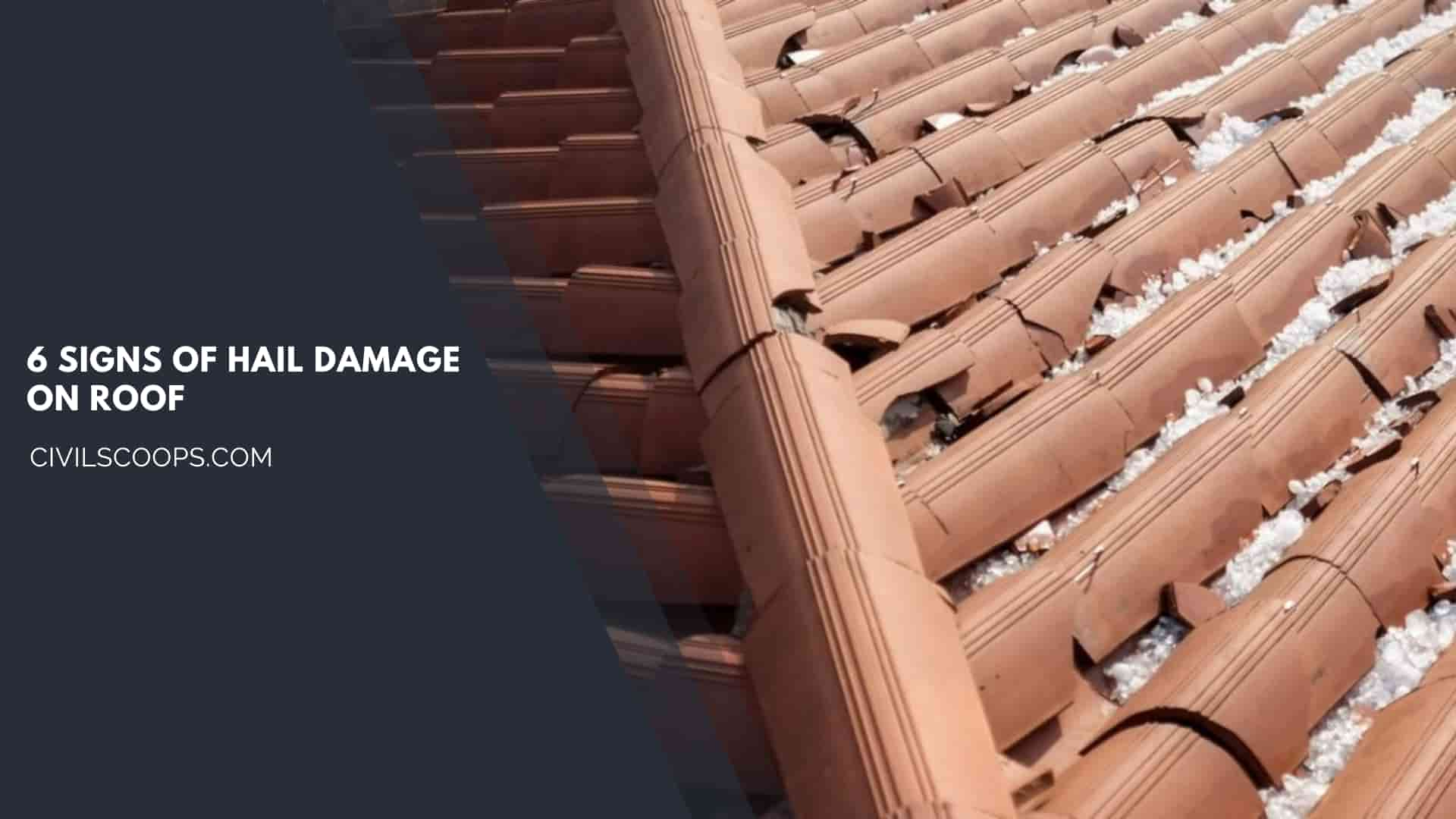
One of the common questions homeowners have is about the signs of hail damage on their roofs. Hail can damage different roofing materials in varying degrees.
For instance, the effects on wood, asphalt, metal, and slate can differ.
Recognizing hail spatter marks or understanding how to tell if your roof has hail damage is crucial.
These products are getting damaged differently by the hailstorm.
- Hailstorm is the cause of huge damages on wooden shingles by which the shingles get split and sometimes broken.
- Naturally, split shingles have sharp edges and corners. Split in the shingle has been determined in the middle, but no damages at the edges of the shingles.
- Metal shingles get cracked, crushed, or anything other can happen with metal shingles due to hailstorms. The metal coating is also removed, and scouring is observed.
- Slate shingles are getting cracked, totally broken in maximum times, and holes are also created in this type of shingles.
- In asphalt shingles, granules get removed and become shiny in nature. It is also very harmful to the roof itself also. The colors of those shingles also changed.
- Damage signs are also visible in the asphalt shingles due to hail storms.
Hail Damage to Roof Vents and Shingles
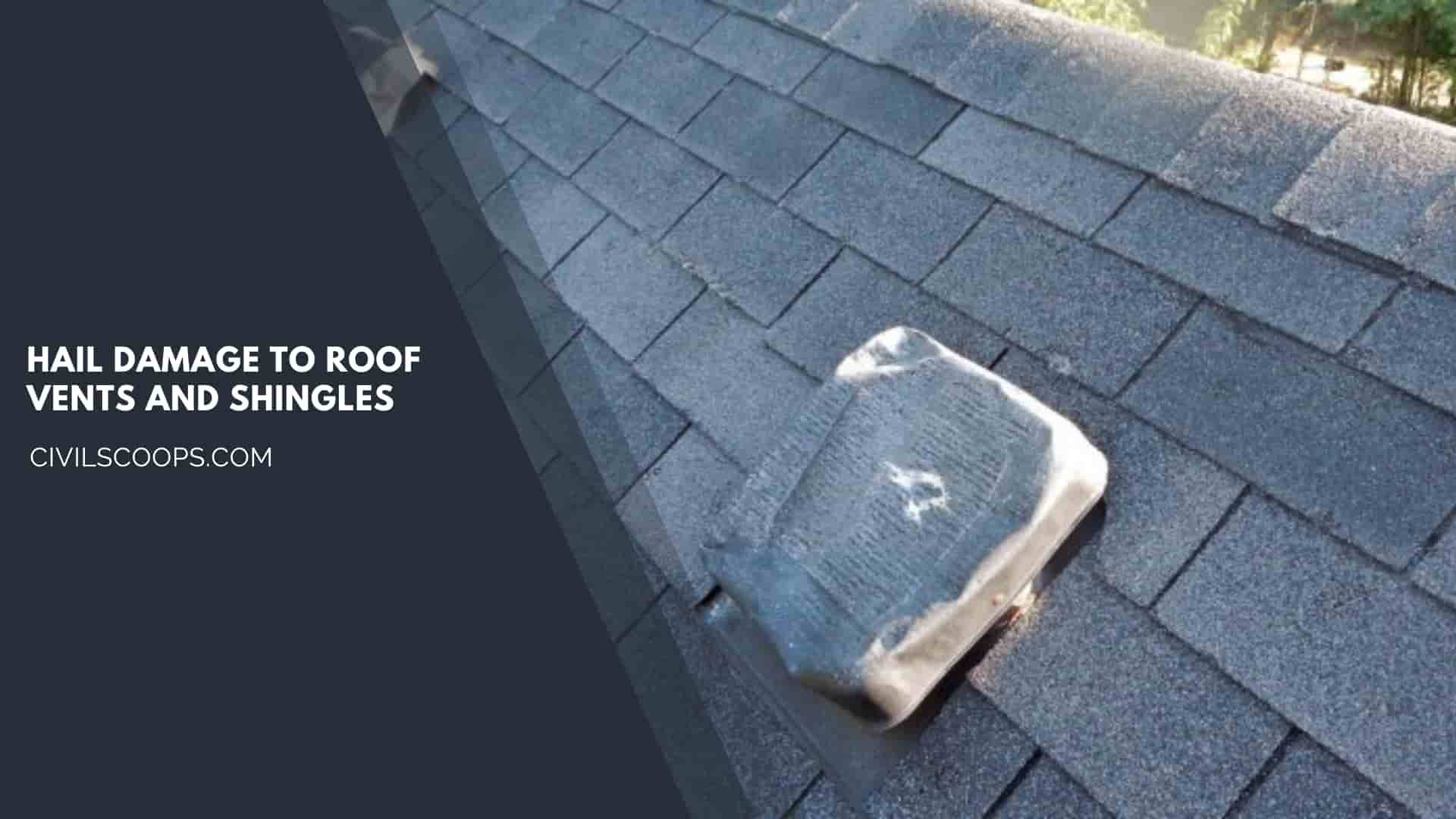
Roof vents are almost constructed in every house, and it helps to circulate the airflow in the building and provide a way to enter the sunlight in the building.
Roof vents are generally made with glass, so, due to hailstorms, those glasses are totally damaged, like cracked or totally broken.
This creates a huge loss for the owner.
Shingles are also damaged by hail storms. The damages in shingles are- Hail created a huge impact on the asphalt and composition shingles and turned it into the black in color.
Due to Hail, granules in asphalt get removed and become shiny in nature. It is also very harmful to the roof itself also.
Slate shingles are getting cracked, totally broken in maximum times. Hailstorm is very dangerous for the slate shingles.
Also Read: Water Damage in Bathroom | How to Fix a Water Damage Bathroom | Signs of Water Damage in Bathroom
What Does Hail Damage Look Like on Shingles Roof?
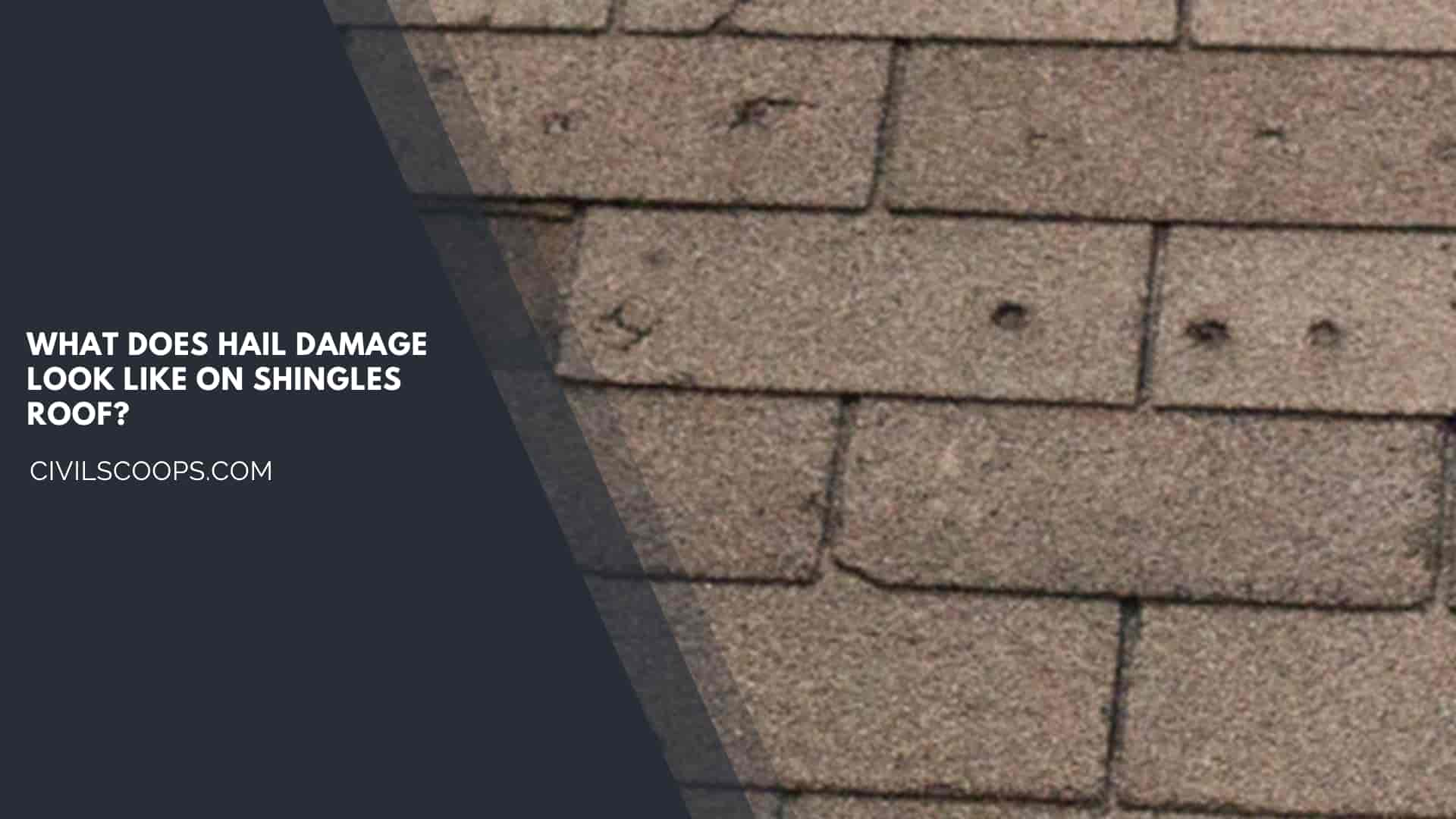
Hail damage creates different damage impacts in roof shingles. Naturally, roof shingles are made with slate, metal, wooden, etc.
So, the damages on various roof shingles are.
1. Wood Shingles Damage
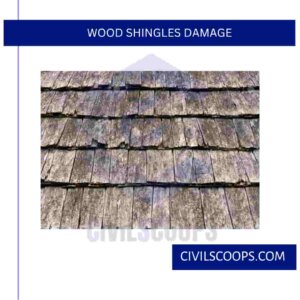
Wood shingles are easily damaged by hailstorms because they are very weak to resist that kind of storm.
Some effects of hail damage on wood shingles are.
- The wooden shingles will split, which are orange or brown in color.
- Hailstorm creates random damages on wooden shingles.
- Generally, split shingles have sharp edges and corners. Split in the shingle has been determined in the middle, but no damages at the edges of the shingles.
- Damage marks are seen along with the splits, and it also creates impact damages on the roof shingles or roofing materials.
2. Asphalt and Composite Shingles Damage

Generally, asphalt and composite shingles are much harder and stronger than wooden shingles, they can even resist the hailstorm damage more perfectly and accurately, but there is also some damages are observed in asphalt or composition shingles, those are-
Hail created a huge impact on the asphalt and composition shingles and turned it into black in color.
Random damage patterns are visible in the asphalt shingles after the Hail.
Due to Hail, granules in asphalt get removed and become shiny in nature. It is also very harmful to the roof itself also.
Sometimes, Hail does not hit too much harder; it hits smoothly and creates less impact on the roof shingles like asphalt or composition shingles.
3. Metal Shingles Damage
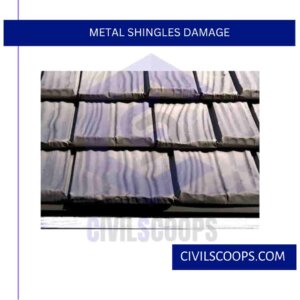
Due to hailstorm, the upper coating of the metal shingles is removed; so, it shows a scouring effect. The roof is pelted because of Hail, and the damage is measured by the speed of air of Hail.
The material gets cracked, crushed, or anything other can happen with metal shingles due to hailstorms.
4. Slate Shingles Damage
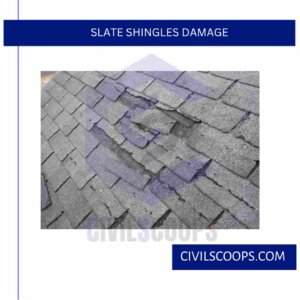
By the hailstorm, the slate shingles are getting cracked, totally broken in maximum times. Hailstorm is very dangerous for the slate shingles.
Due to Hail, holes are created in the slate shingles, and it is not usable in maximum time.
Also Read: Types of Wooden Beams
Useful Article for You
- How Wide Is a Cinder Block
- How Much Is a Coffered Ceiling
- How to Make Mortar
- How Long Does Hempcrete Last
- How to Use a Hand Sight Level
- How to Build a Lean to Roof
- How Are Tunnels Built
- How to Layout a Building
- How Wide Is a Car Parking Space
- How Do Shear Walls Work
- How to Measure Concrete Slump
- How to Use Washers with Screws
- How Dense Is Sand
- How High Is a Window from the Floor
- How Does a Beam Bridge Work
- How Do They Pour Concrete Under Water
- How Does a Sewer System Work
- How High Are Countertops
- How to Seal Brick Wall Interior
- How to Resurface Cement
- How to Use Portland Cement
- How Is Plaster Made
- How Many Types of Slope Are There
- How Big Is a Stair Landing
- How to Get Paint Off Concrete Without Chemicals
- How to Fix Water Damaged Drywall
- How Much to Get Septic Pumped
- How to Cut a Nail or Screw
- How Long Does Wet Concrete Take to Dry
- How Is Varnish Made
- How Does Ejector Pump Work
- How Does Hydrometer Work
- How to Get Wet Blood Out of Carpet
- How to Build House on Slope
- How Thick Is Plaster Wall
- How Suspension Bridges Work
- How to Seal a Concrete Roof
- How Was Cement Invented
- How to Calculate Area of Steel
- How to Check Silt Content in Sand
- How a Building Is Constructed
- How Are Roads Classified in India
- How Many Types of Cement in India
- How to Find Contour Interval
- How Hardness of Brick Is Tested
- How Many Types of Paint Brushes Are There
- How to Calculate Skirting Area
- How Many Types of Beam
- How Many Types of Chain in Surveying
- How to Find One Way and Two Way Slab
- How Many Types of Houses
- How to Find Steel Bar Weight
- How to Calculate Septic Tank Capacity in Liters
- How to Calculate the Bearing Capacity of Soil
- How Many Types of Bricks Are There
- How Many Types of Cement Are There
- How to Make Block
- How Many Types of Bridge
- How Much Sand Required for 1 Sq.feet Area
- How to Texture Walls with Paint
- How Many Type of Beam
- How Is Tar Made
- How to Stop Water Leakage from Terrace
- 1cum How Many Bricks
- How to Calculate Shear Force and Bending Moment
- How to Building
- How to Calculate Fineness Modulus
- How to Find Zero Force Members in a Truss
Metal Roof Hail Damage
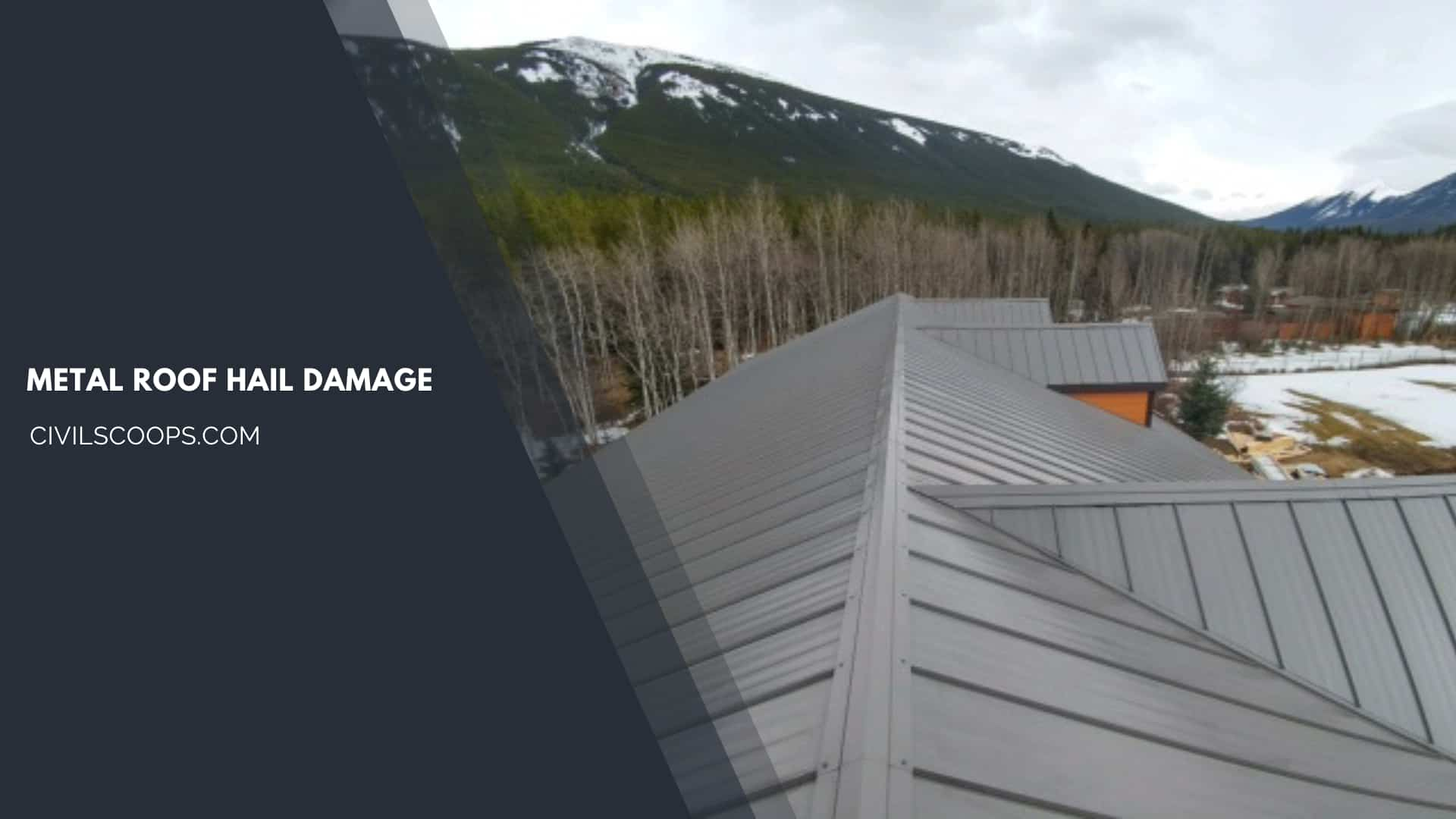
When it comes to hail damage on metal roof shingles, even though they are among the tougher roofing materials, they are not immune to the effects of hail storms.
It’s essential to identify the signs of hail damage and know ‘How do I know if my roof has hail damage?
There are several types of damage that can happen in the metal roof, those are-
- Denting may happen due to hail storm; so, a portion of the panel is dented from the roof, and due to this aesthetic issue will appear, there are no chances of failing by this reason. Someone needs to fix and repair those portions, and the roof is totally ready to repair.
- Due to a hail storm, some random sharp-edged particles hit the metal roof; so, for this reason, a leak is observed in the roof. Puncturing in the metal roof is common after Hail.
- Sometimes, metal shingles are also broken due to this hail storm. It is very dangerous, and it needs proper repair works and maintenance for further use.
What About Hail Spatter?
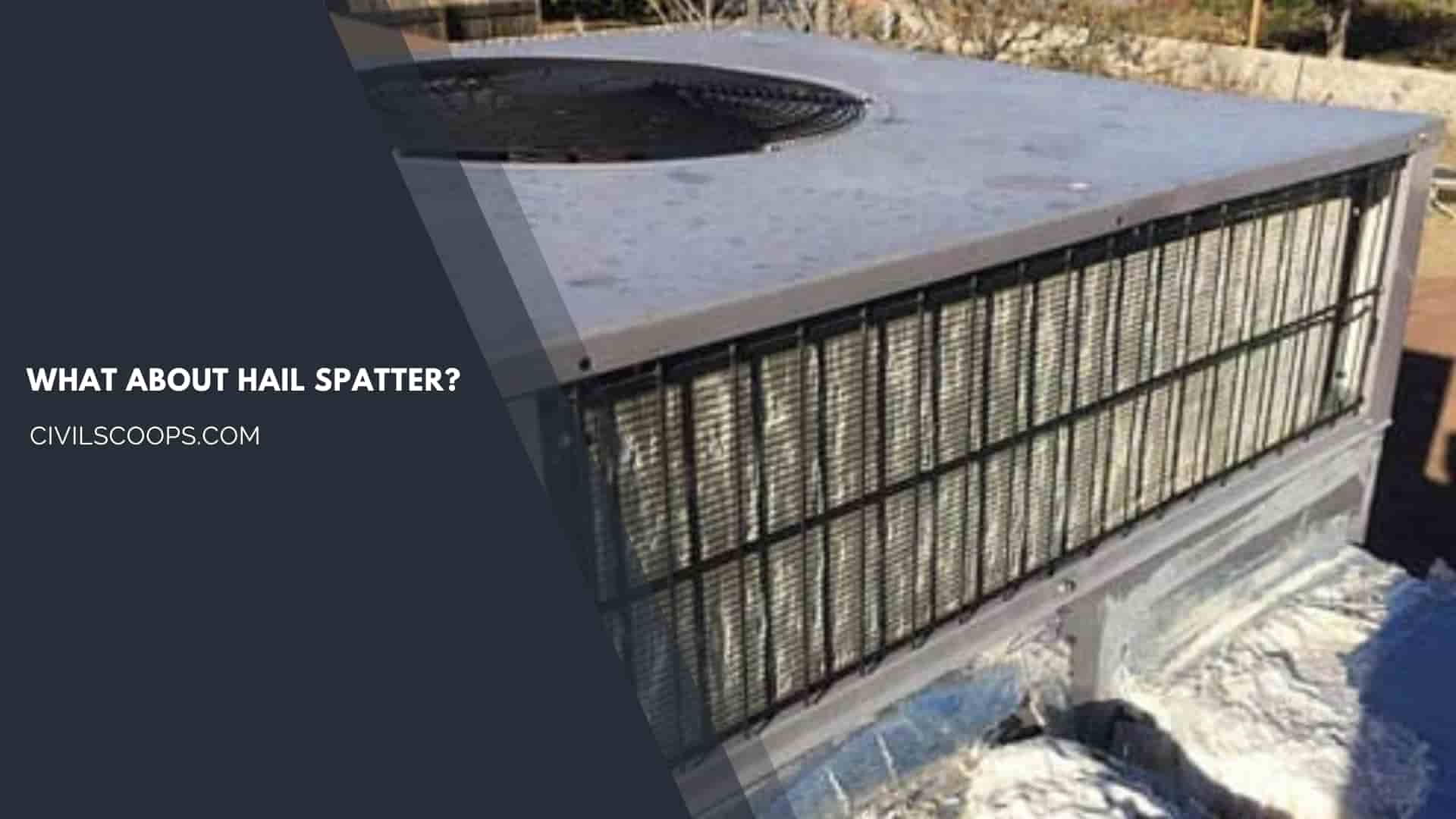
On the roof, shingles, or other materials, there are painted components or other materials like oxidation materials, dirt, leaves, algae, and grime stored.
A common aftermath of hailstorms is hail spatter marks on siding and other surfaces.
There is a temporary marking is happens after a hail storm, which is termed as Hail spatter.
Hail spatter may damage the roof shingles, or it may not damage the roof shingles; it totally depends on the hailstones.
Hail spatter is a very important thing because it removes the dirt, grime, and other materials & leaves a mark on roof shingles by which we can easily detect the damages on the roof and the size of hailstones, the direction of hailstone and speed of hailstones.
In soft metals, we can easily detect the hail storm damages and the density of hailstones.
So, Hail spatter can damage your roof shingles, but it will also help a lot more; it cleans the roof shingles from algae, dirt, debris, grime, etc.
And by Hail spatter, you can easily detect the hailstones’ density.
What Size Hail Will Damage a Roof?
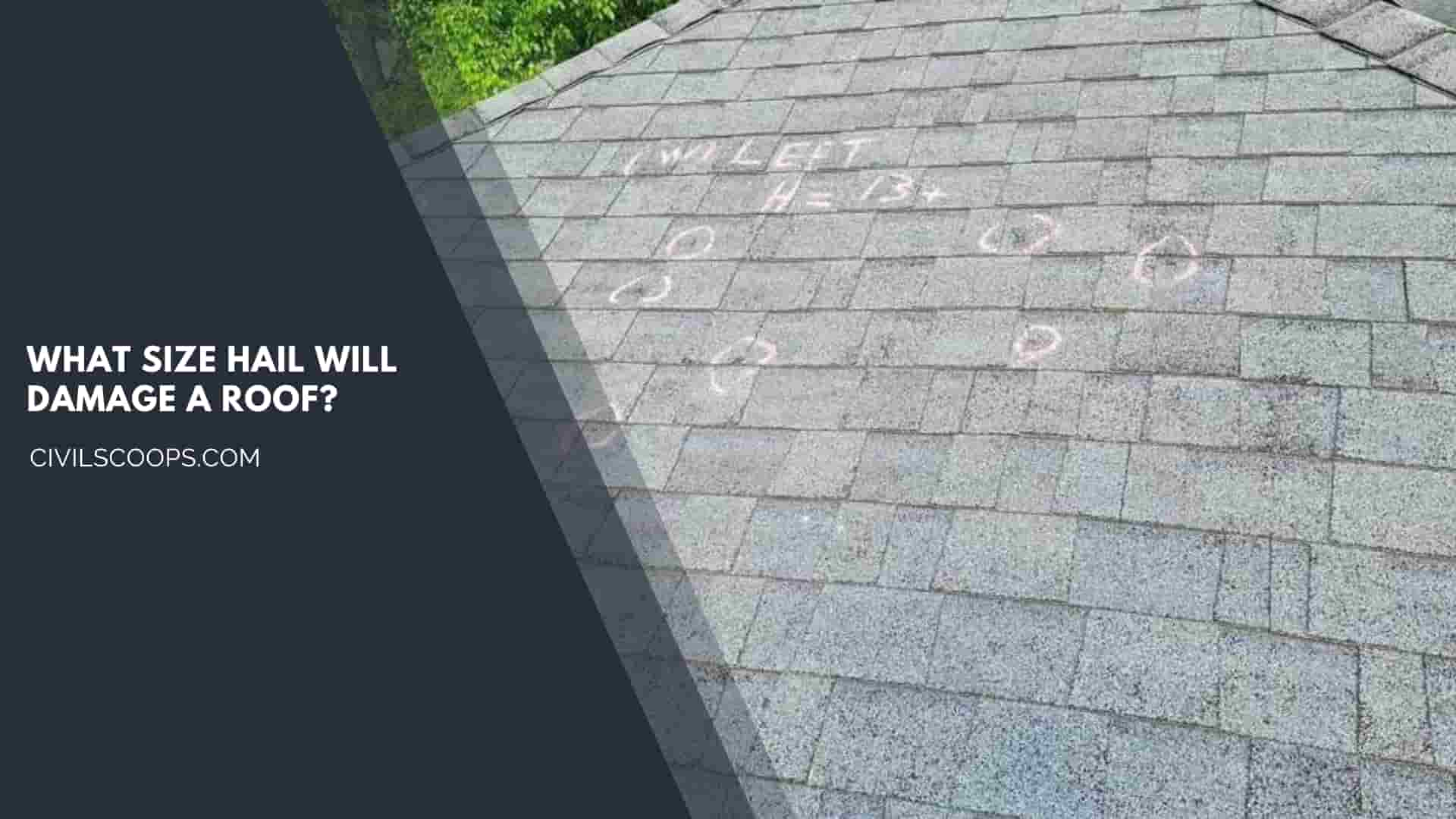
A frequent query among homeowners is, ‘how do you know if your roof has hail damage?‘ While hail can cause significant damage to roofs, often the extent of damage is less if the hailstones are small, but if the sizes of hailstones are bigger in nature, then it may cause huge damage and a major loss for your roof.
It also costs too much money for repairing purposes.
There are some sizes hail causes roof damages; they are different in size, and different damage property is observed and also create a different impact on your roof.
1. ¼-inch Hail
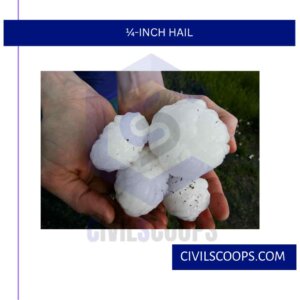
This is the first size of Hail which is widely known as pea-sized Hail.
In this type of storm, a mild hailstorm can produce this type of Hail, and it stays near for about a few minutes with a steady rainfall.
New roofs are not damaged by this type of hail size, but if your roof is a little bit older, then your roof is getting damaged by this type of hail storm.
2. ½-inch Hail
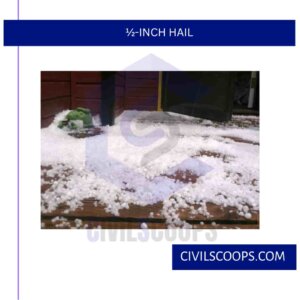
This is the second size of Hail which is widely known as marble-sized hail.
This type of Hail does not damage your roof directly because wind goes to the upper portion atmosphere, becomes snow, and falls down to the earth due to gravity.
When the extreme wind is blown, then this type of Hail can create damages to your roof, and then the size of the Hail becomes quarter-inch-sized.
3. ¾-inch to 1-inch Hail
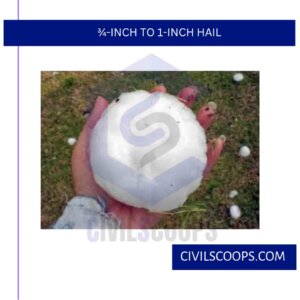
This is also another type of Hail which is widely known as a dime to quarter size hail.
If the size of hailstones is greater than ½ inch, then you should immediately call a roof inspector to inspect the roof.
This type of hail size can create a crack in your roof, which is very dangerous, and you should call a roofing contractor.
You should also hire an insuring agent who prepares all the policies and talk with your roofing contractor about the dealing of damage.
4. 1-Inch to 4-Inch Hail
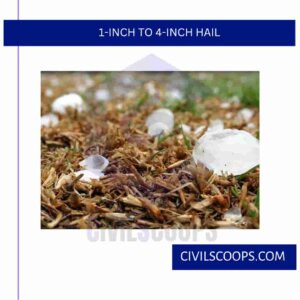
This is the final size of Hail which is also known as gold ball-sized Hail.
This is the uncommon size of Hail which can create huge damage on your roof, home, car, etc.
If this type of Hail is done, then there is damage surely. In this type of situation, you should hire an insurance agent and a roofing contractor to inspect the roof.
After that, the roofing contractor will inspect your roof in detail and find out the damages on your roof and the portion where hail hits, and then start all the necessary repairing works.
This process is also a very cost-effective process; so, you need to calm and find out the best and professional contractor for your roof repairing purpose.
What Does Hail Damage Do to a Roof?
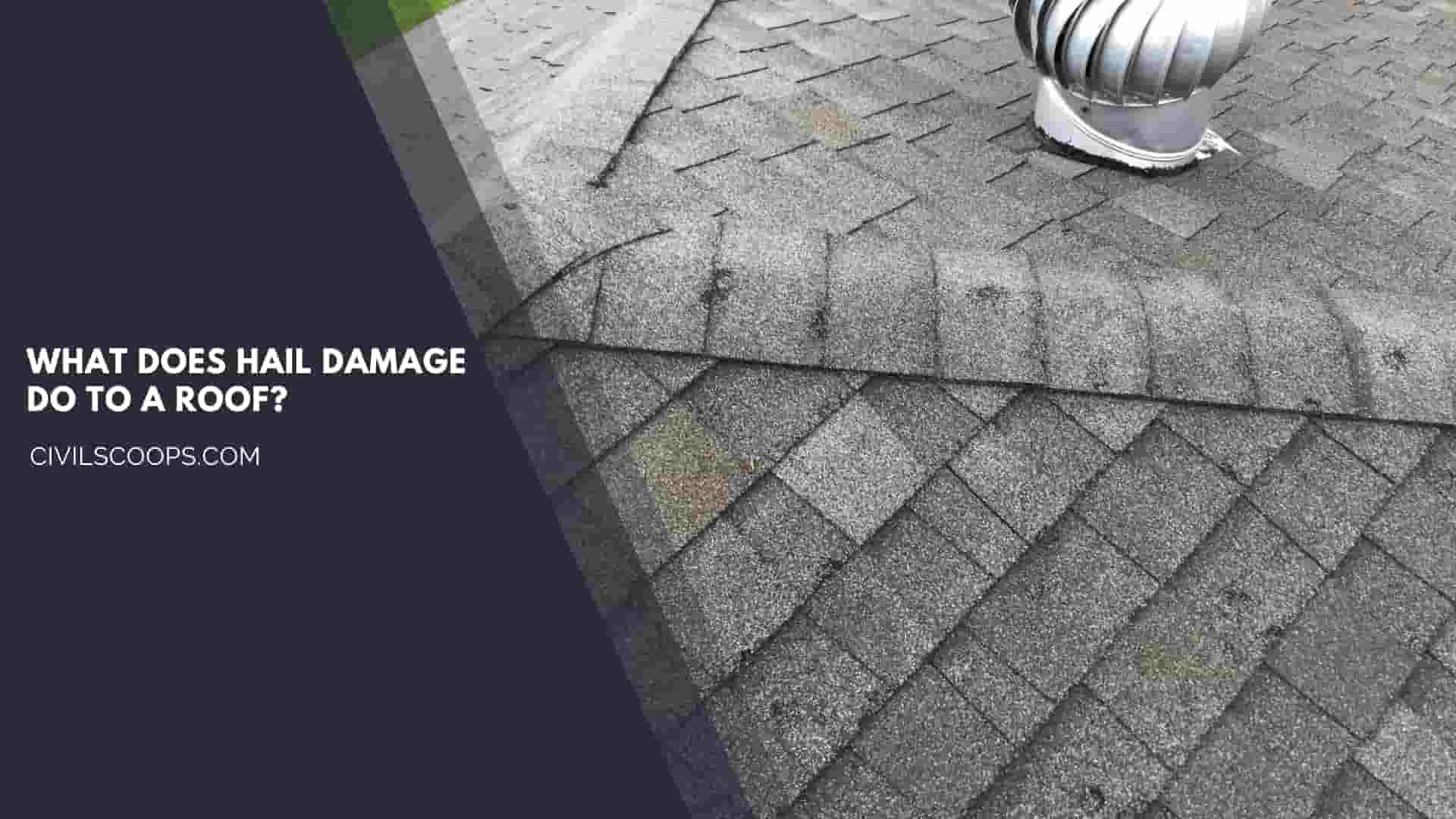
Hail damage creates different impacts in different types of materials, like the impact on asphalt and composite shingles are different than wooden shingles.
Generally, shingles of the roof react differently when they are struck by Hail.
So, it is mandatory and important to know about the types and intensity of damage to perfectly detect the damages for restoration and repair of roof shingles.
What Do I Do If I Think I Have Hail Damage?
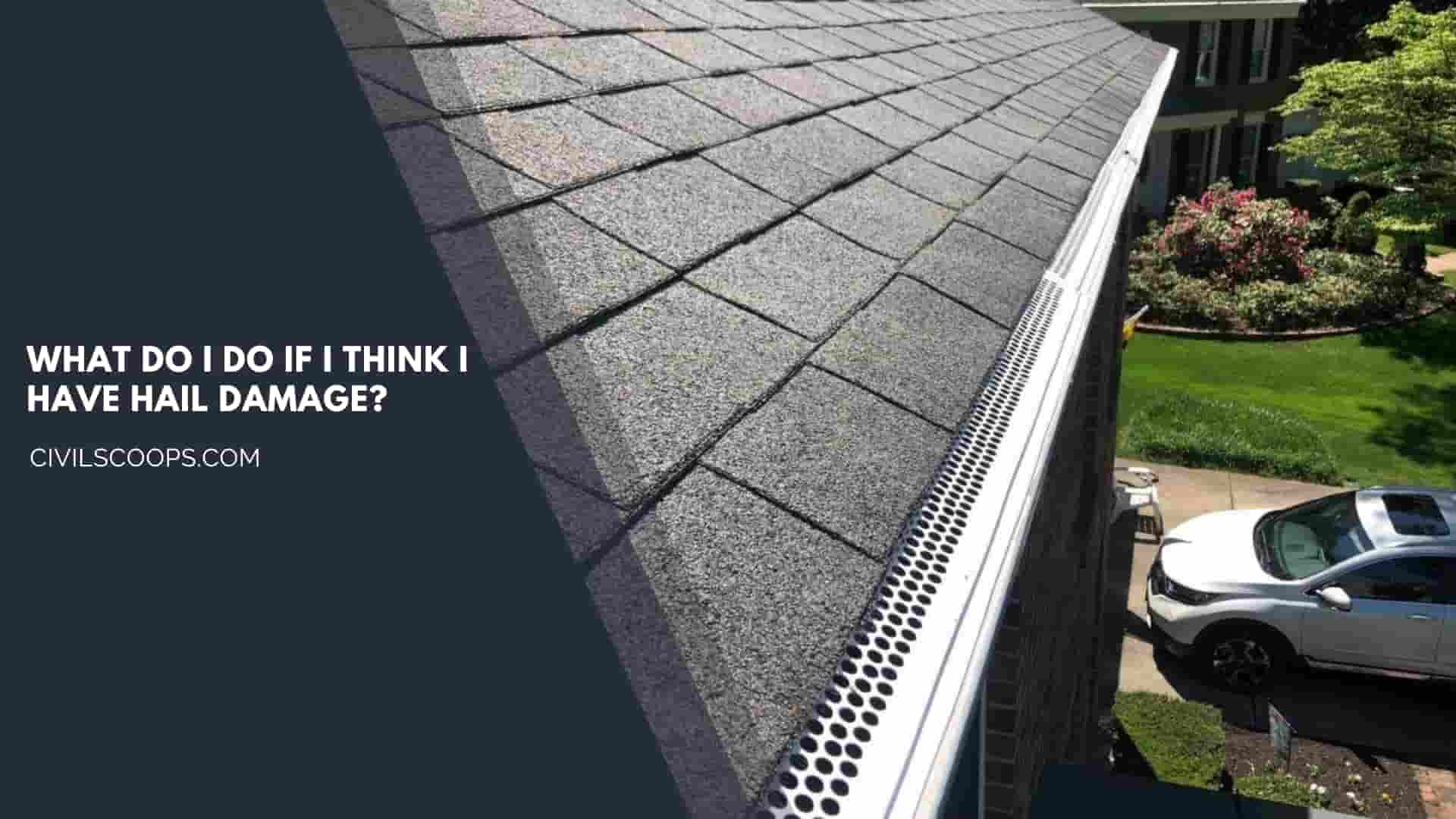
If you suspect hail damage to metal roof or any other type, and notice that only one or two roof shingles or shakes are punctured or split, they can be removed or replaced.
- When you see or discover the failed damage on your wooden roof, at first, we have to determine how much damage occurs there.
- For this job you can hire a local contractor, he or she can easily handle this problem.
- If you inspect your roof and find that most of the shingles or shakes are damaged, then you have to replace the whole roof.
How to Spot Hail Damage on Roof?
- Random damage with no discernable pattern.
- Hail hits that are black in color.
- Loss of granules, which may expose the roof felt.
- Asphalt and/or mat that appears shiny.
- Hail hits that are soft to the touch, like the bruise on an apple.
How to Spot Hail Damage?
The presence of one or more of these signs is an indication that you might have more hail damage on your roof.
- Dents and Dings on Your Siding or Window Sills.
- Damage to Your Decks and Porches.
- Hail Damage to Gutters and Downspouts.
- Window Screens.
- Damage to Air Conditioning Units.
What Does Hail Damage Do to a Roof?
Hard hail impacts or high winds can grip the shingles and cause cracks. This can lead to exposure and tears, leaving your roof with bare spots. Cracked shingles cannot effectively protect your roof from the weather.
What Can Hail Do to a Roof?
For example, hail can cause dings in aluminum siding, gutters or asphalt shingles, whereas it can crack vinyl siding or wood shakes. Alternatively, softball-sized hailstones can be dense enough and strong enough to puncture a roof. Additionally, the age and condition of a roof could affect the degree of damage.
What Size Hail Can Damage a Roof?
one inch
Generally speaking, hailstones at least one inch in diameter can cause damage to a roof. Smaller hailstones can cause damage, especially when accompanied by strong winds or when striking roofing materials that were not engineered to withstand hail impact. As hail size increases, the potential for damage also increases.
What Size Hail Does Roof Damage?
The size of hailstones that can cause roof damage typically starts at around 1 inch (2.54 cm) in diameter or larger. Hailstones of this size or larger can dent shingles, cause granule loss, and even create holes in roofs, especially if the hailstorm is accompanied by strong winds.
What Is Hail and How Does It Form?
Hailstones are formed when raindrops are carried upward by thunderstorm updrafts into extremely cold areas of the atmosphere and freeze. Hailstones then grow by colliding with liquid water drops that freeze onto the hailstone’s surface.
How to Tell If Your Roof Has Hail Damage?
More signs of hail damage to your roof are dings/dents/splatter marks to your roof vents, gutters, roof flashing, and other roof penetrations. If your roof has any of the damage listed above, it’s a good chance you’ll have a homeowners insurance claim.
How to Know If Your Roof Has Hail Damage?
If you take a look at your roof and find that any of the flashing is bent, dented, or otherwise damaged, it’s likely hail has hit your roof. The same goes for any vents or plumbing boots. These are all made of metal and will show signs of wear after being hit by hailstones.
How Can You Tell If Your Roof Has Hail Damage?
Signs of hail damage on a roof include dented or bruised shingles, missing granules, cracked or split shingles, leaks inside the house, damaged gutters or vents, and dents on metal surfaces.
Metal Roof Hail Damage
The good news is that metal roofing is highly resistant to hail and unlikely to suffer critical damage during a storm. Instead, the most likely effects of hail will include denting or potential scratching.
Hail Damage to Roof
A lot of little hail can impact your roof and shorten its lifespan over time, especially if it’s exposed to hail often. But for hail to damage your roof and lead to a replacement after a storm, it needs to be a pretty good size. Hail around 1” in diameter or bigger will damage your roof and warrant an insurance claim.
What Size Hail Will Damage a Roof?
Hailstones around 1 inch (2.54 cm) in diameter or larger can potentially damage a roof. However, the severity of damage can also depend on various factors such as the type and condition of roofing materials, the angle and force of the hail impact, and the duration of the hailstorm. Smaller hailstones can also cause damage, especially to older or less sturdy roofs.
Metal Roofs and Hail Damage
During a hailstorm, if you have a metal roof you have extra protection against denting, tearing, or puncturing from hail. Other roofing materials, such as asphalt shingles, do not perform as well in these conditions and often result in shingles needing to be repaired or replaced after storms.
What Does a Roof Look Like with Hail Damage?
You should spend most of your time checking the shingles on the roof. Hail damage to shingles will have small or large dents and dings on them, as these are telltale signs of hail damage.
What Size Hail Will Damage a Metal Roof?
Hail size determines how much damage metal roofing panels can sustain. Generally, any hailstone larger than one inch in diameter can cause dents on its surface.
Like this post? Share it with your friends!
Suggested Read –